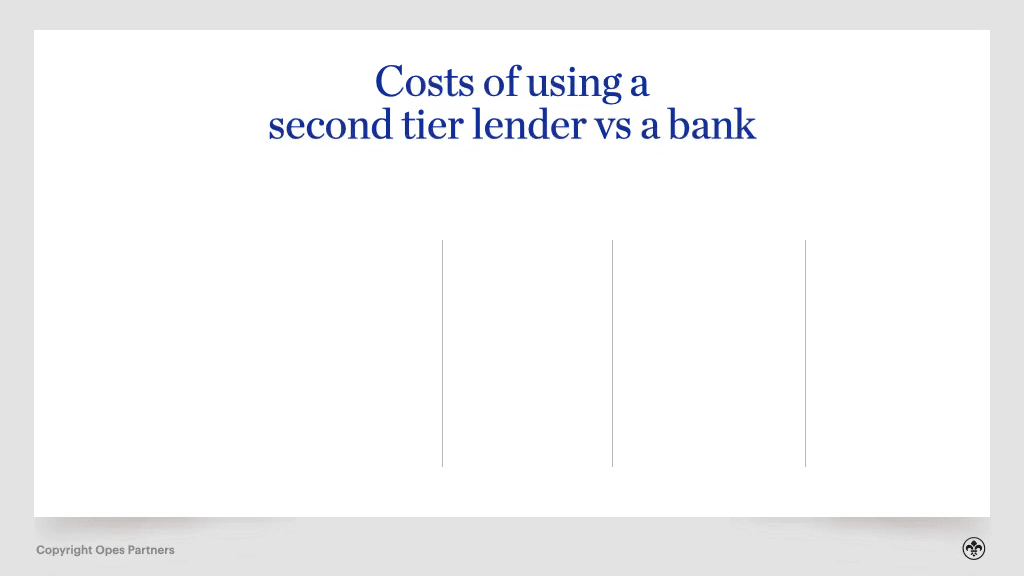
Mortgages
How do I get a mortgage and pay it off?
This 9,500-word Epic Guide to Mortgages is the definitive article on how to get a mortgage and pay it off faster, today in 2026. The Ultimate Guide.
Mortgages
8 min read

Author: Laine Moger
Journalist and Property Educator, holds a Bachelor of Communication (Honours) from Massey University.
Reviewed by: Ed McKnight
Resident Economist, with a GradDipEcon and over five years at Opes Partners, is a trusted contributor to NZ Property Investor, Informed Investor, Stuff, Business Desk, and OneRoof.
Second tier lenders have an unfair reputation as being a bit “dodgy”.
Not only is this reputation untrue, but it can put up an unnecessary barrier for investors looking for a viable and professional alternative to the main banks.
Let’s set the record straight. Second tier lenders are tightly regulated, professional and responsible lenders.
Yes, banks will usually have more attractive rates and are ultimately cheaper. But you have to meet their tight lending criteria to reap the benefits.
In this article you’ll find out what exactly a second tier lender is and whether or not they could be an option (or solution) for you and your portfolio.
And if you have a question, write your questions or thoughts in the comments section below.
Banks and second tier lenders will lend you money to purchase a residential property. That could be for you to live in yourself or as an investment. But there are some key differences.
It’s quite simple, a bank can call itself a bank because it is registered with the Reserve Bank of New Zealand. Second tier lenders are not registered.
Banks will also offer a range of financial products like credit cards, term deposits, overdrafts or transaction accounts. Second tier lenders don’t do any of that extra stuff. So, don’t rock up to a second tier lender looking for a credit card.
There are around 20 to 30 second tier lenders available in New Zealand that property investors can use. And the industry is growing.
Some of the more commonly used second tier lenders you might have heard of are:

For more information about what some of these second tier lenders offer, head to our article: Top 5 non-bank lenders
Although they won’t like us saying it, all the main banks – like Westpac, ASB, ANZ and BNZ – are very similar.
They offer similar rates and mortgage structures.
Second tier lenders are different. They’ll come up with different mortgage types and structures for different borrowers.
For instance, Basecorp is really good for people who flip and trade properties. Whereas First Mortgage Trust works well for developers. Resimac is sometimes a good fit for long term buy-and-hold investors. More on how this works below.
Second tier lenders lenders take a pragmatic approach. That means they assess loan applications on a case-by-case basis. Because they are small they can create specific services and products for specific segments of the market the main banks don’t serve.
There aren’t any hard and fast rules about who they will and won’t lend to. This is different for banks, who can live and die by some of their lending criteria.
But it’s important to note both institutions are governed by the same laws.
So, the second tier lenders are not the cowboys you may have heard - they are consummate professionals tightly regulated by consumer credit governing bodies.
Traditionally speaking, second tier lenders were the Plan B option for borrowers who didn’t meet a bank’s lending criteria.
They worked (and still work) for people who:
But stricter lending conditions, in the form of debt-to-income ratios, LVRs and the recent CCCFA changes, means more people are failing to meet the tough criteria the main banks set.
This means the main banks are rejecting more people than they have in the past. So more Kiwis are turning towards their second tier counterparts.
So, the real answer to this question of who is suited to a second tier lender is: Any borrower, really.
If you can get approved by a main bank, you’d typically go with them. But, if you can’t get through their lending criteria, that’s cool. It’s time to talk to a second tier lender.
Many investors scratch their heads and wonder: Where do second tier lenders get their money from? This is one of the big differences between banks and second tier lenders.
A bank will get money from term deposits. An investor might give them $100,000 and the bank will pay a 2% interest rate. Then they might lend that money out at 4% to a borrower.
Second tier lenders are different. They’ll often:
So a second tier lender might borrow money from a bank like the Commonwealth Bank of Australia and then lend that money to you at a higher interest rate.
Of course, it’s a bit more complicated than that and there are some big words that even we struggle to pronounce. But, before you start quoting The Big Short, don’t stress – this is all safe, legal and regulated.
Traditionally it’s been thought that second tier lenders, as the second-tier solution, charge substantially higher interest rates. That’s not always true.
It really depends on you, your situation, and how much risk you pose to the lender.
That’s because second tier lenders work on risk-based pricing.
So if you’re a discharged bankrupt and have multiple unpaid bills, then you’re seen as higher risk. That means you’ll be charged a higher interest rate.
On the other hand if you pay your bills on time, have a regular income, but have been turned down by the bank because you eat too many takeaways, you’re lower risk. So, you’ll be charged a lower interest rate. In second tier terms, you’d be known as a “prime customer.”
In this instance it is likely you would see similar if not better interest rates from a second tier lender.
Interest rates aren’t everything when it comes to borrowing.
And second tier lenders do have additional charges, which you must consider when making your decision.
For instance, a second tier lender will often charge:
Additionally, a bank is likely to give you a cashback when you take out your mortgage. For instance, one of the main banks currently offers a $3K cashback when securing a mortgage. This is useful for paying your legal fees when purchasing a property. You miss out on this if you go with a second tier lender.
So the difference in establishment fees could be $4k – The $1k establishment fees and missing out on a $3k cashback.

Yes, it is still in your best interest to use a mortgage broker. Why? Because there are up to 20 non-banks. A broker will go a long way to finding you the right one for your situation.
This is similar to a main bank. For example, ANZ will not currently take into account income earned from overtime but Westpac will, so nurses applying for a mortgage are generally more suited to Westpac.
Similarly, BNZ currently has policies more favourable for women on maternity leave who are about to return to work.
The same rule applies to second tier lenders. From the outside two might look similar, but once you get behind and look at their lending policies one can be better than another, depending on the situation.
A mortgage broker will steer you in the right direction.
Second tier lenders are going to become more common.
Currently, only 2% of New Zealand’s mortgage market is made up of second tier lending. But in Australia this figure is much higher at 20%.
New Zealand is likely to follow suit.
So, if you are struggling to get a mortgage approved at a main bank, make sure you ask your mortgage broker about second tier options.
Financially speaking, the pros to second tier lenders are:
Whereas the cons are:
Yes, you’ll pay extra, but if you want the lending and can’t get it elsewhere, that’s the price you may have to pay.
Write your questions or thoughts in the comments section below.
Journalist and Property Educator, holds a Bachelor of Communication (Honours) from Massey University.
Laine Moger, a seasoned Journalist and Property Educator holds a Bachelor of Communications (Honours) from Massey University and a Diploma of Journalism from the London School of Journalism. She has been an integral part of the Opes team for four years, crafting content for our website, newsletter, and external columns, as well as contributing to Informed Investor and NZ Property Investor.
This article is for your general information. It’s not financial advice. See here for details about our Financial Advice Provider Disclosure. So Opes isn’t telling you what to do with your own money.
We’ve made every effort to make sure the information is accurate. But we occasionally get the odd fact wrong. Make sure you do your own research or talk to a financial adviser before making any investment decisions.
You might like to use us or another financial adviser